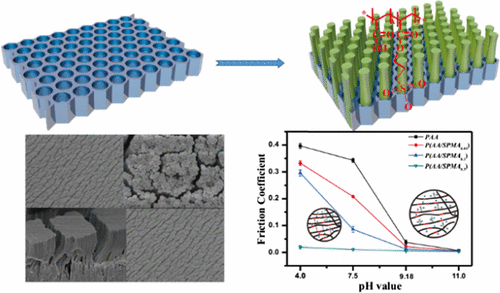Abstract: One of the most prominent properties of hydrogels is their excellent hydrolubrication that derives from the strong hydration of the gel network. However, excessive hydration makes hydrogels exhibit a very poor mechanical property, which limits their practical applications. Here, we prepared a novel composite surface of hydrogel nanofibers embedded in an anodic aluminum oxide substrate which exhibited both excellent lubrication and a high load-bearing capacity. Through the copolymerization of acrylic acid and 3sulfopropyl methacrylate potassium salt, the gel network swelled sufficiently in aqueous solution and caused high osmotic pressure repulsion to bear heavy loads and hence exhibited excellent aqueous lubrication (mu approximate to 0.01). Notably, the friction coefficient of gels showed no dependence on the load in the experiment, whereas it was strongly influenced by the sliding velocity. Additionally, both electrolyte solution and ionic surfactants affect the conformation of the polymer chains, which results in a significant impact on the friction properties of hydrogel fibers. KeyWords Plus: POLY(ACRYLIC ACID) HYDROGELS; SODIUM DODECYL-SULFATE; MECHANICAL STRENGTH; ARTICULAR-CARTILAGE; FRICTION; SURFACTANTS; SURFACES; BRUSHES; IONS; GELS Published in LANGMUIR, 33 (9):2069-2075; 10.1021/acs.langmuir.6b03883 MAR 7 2017 |
